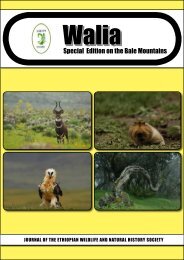Biodiversity of Mahale Mountains National Park, Tanzania | Report ...
Biodiversity of Mahale Mountains National Park, Tanzania | Report ...
Biodiversity of Mahale Mountains National Park, Tanzania | Report ...
Create successful ePaper yourself
Turn your PDF publications into a flip-book with our unique Google optimized e-Paper software.
<strong>Biodiversity</strong> <strong>of</strong> <strong>Mahale</strong> <strong>Mountains</strong> <strong>National</strong> <strong>Park</strong><br />
not followed by the authors <strong>of</strong> the Birds <strong>of</strong> Africa (Keith 1992). They follow Hall and Moreau<br />
(1970), and preferred to wait until more information on the biology <strong>of</strong> this species became<br />
available before making a final decision on whether to treat insulana and bocagei as separate<br />
species.<br />
Immediately preceding this survey in August 2005, I had the opportunity to carry out a<br />
biological survey 60 km to the east <strong>of</strong> <strong>Mahale</strong> in the Sitebe-Sifuta <strong>Mountains</strong>. I found<br />
Bocage’s Robin, S. bocagei ilyai to be common in gallery forest along the Mbala Stream at<br />
1700 m and made recordings <strong>of</strong> the song. During fieldwork in <strong>Mahale</strong>, recordings <strong>of</strong> the song<br />
<strong>of</strong> endemic subspecies <strong>of</strong> Bocage’s Akalat, S. bocagei kungwensis were made at 2400 m in<br />
the forest around Mfitwa Mountain.<br />
Figure 3<br />
Spectrogram <strong>of</strong> the songs <strong>of</strong> Alexander’s and Bocage’s akalats.<br />
Although the birds looked identical, their songs and habitat are completely different. The<br />
song <strong>of</strong> kungwensis is virtually identical to the song <strong>of</strong> insulana from Mt. Cameron, whereas<br />
the song <strong>of</strong> ilyai is identical to that <strong>of</strong> S. bocagei chapini from northern Zambia and southern<br />
<strong>Tanzania</strong> (Chappuis 2000). The fundamental frequency <strong>of</strong> the song phrase <strong>of</strong> Alexander’s<br />
Akalat is 1257 Hz and the highest frequency is1943 Hz. The fundamental frequency <strong>of</strong><br />
Bocage’s Akalat is 2715 Hz with the highest frequency at 4537 Hz (Table 3). Claude<br />
Chappuis (in litt.) states that this evidence along is enough to treat them as separate species.<br />
These two forms are within 60 km <strong>of</strong> each other, yet are more similar to distant forms in<br />
vocalizations and habitat choice than to each other. It is clear from this that they are separate<br />
species. So the name <strong>of</strong> the bird in <strong>Mahale</strong> should be Alexander’s Akalat, Sheppardia<br />
insulana kungwensis. Bocage’s Akalat has not yet been found in <strong>Mahale</strong> but it almost<br />
certainly occurs in the riverine forests in the east <strong>of</strong> the park. The subspecies <strong>of</strong> Bocage’s<br />
Akalat in Ufipa is chapini the same at that in northern Zambia (Stjernstedt and Moyer 1982).<br />
The Karema Gap is the likely biogeographical barrier that separates these two forms. In spite<br />
<strong>of</strong> a separation long enough for subspecific differences to have arisen, the songs <strong>of</strong> ilyai and<br />
chapini are virtually identical. Therefore, it is very unlikely that such dramatic vocal<br />
differences could have arisen in ilyai and insulana with no significant ecological or<br />
biogeographical barriers separating them.<br />
Wildlife Conservation Society 16
















